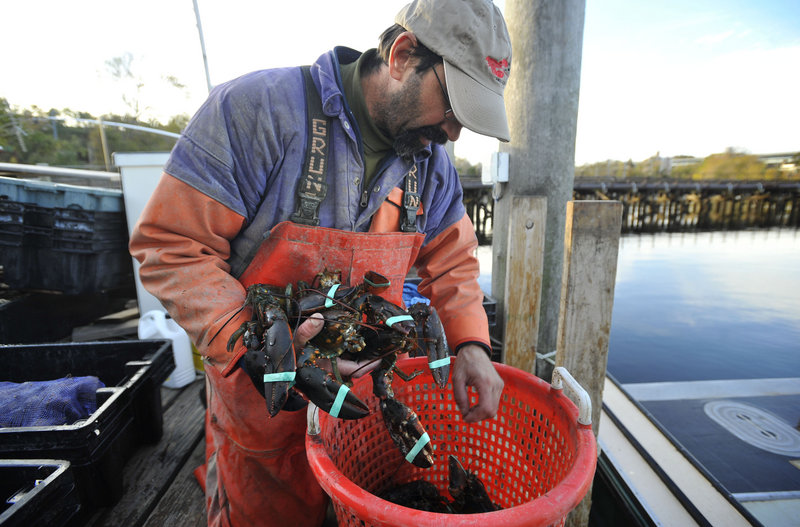HARTFORD, Conn. – Nick Crismale made his career as a lobsterman, but lately there are not enough of the crustaceans in Long Island Sound to make it worth putting out the traps.
Crismale, who dedicated himself to clamming this year, had been among the few remaining holdouts in an industry devastated by a steady decline in lobster stocks. Only about 30 full-time lobstermen are left in Connecticut, down from more than 300 in the years before a devastating lobster die-off in 1999.
“We’re losing a way of life. We’re losing a heritage,” said Crismale, 61, the leader of the Connecticut Commercial Lobstermen’s Association.
Some argued last year that the species was rebounding, and fishermen fought back a proposal for a five-year ban on lobster fishing south of Cape Cod, Mass. But that optimism is fading. Researchers who trawl the waters of Long Island Sound for a survey that began in 1984 say they have never seen so few lobsters.
The 1999 crash was heralded by the typically feisty lobsters turning limp and losing their fight. The pattern has repeated itself each late summer, and state officials say they receive a larger number of anecdotal reports of sick and dying lobsters every year.
While lobsters are thriving in Maine, production is down from a peak in the late 1990s in the area south of Cape Cod through North Carolina. Scientists cannot explain the decline, but possible factors include overfishing, a 1996 Rhode Island oil spill and a disease that disfigures lobster shells but does not taint the meat. They also believe it may be partly explained by warmer water temperatures that have driven lobsters to cooler, deeper waters — away from prime spawning grounds and to places where more predators lurk.
In Long Island Sound, scientists say, commercial lobster fishing may be doomed.
The number of lobsters found by trawlers that take samples at 200 random points in the sound every year has been falling “precipitously” since the late 1990s, said Penny Howell, a marine fisheries biologist with the Connecticut Department of Energy and Environmental Protection in Old Lyme. She said a field crew could not even deliver on a researcher’s recent request for 10 lobsters.
“Whether lobster fishing is going to be commercially viable is highly questionable,” said Howell, who added that she believes the lobster is resilient enough to avoid disappearing from the sound altogether.
Rising water temperatures and runoff contamination are among the suspected culprits in Long Island Sound, an estuary that is bounded by New York City at its western point and has roughly 8 million people living within its watershed area. Howell said water temperatures in the western half of the sound now go above a 68-degree threshold for lobsters for weeks at a time in the summer, leaving them vulnerable to any additional stresses. She said the same phenomenon is playing out in Rhode Island and southern Massachusetts.
Earlier this month, state Rep. Terry Backer, a former lobsterman, arranged a meeting of fishermen who asked state lawmakers to urge neighboring New York state to stop using methoprene, a pesticide used to kill mosquitoes that may carry the West Nile virus.
“If you put something that’s designed to kill things into the environment, you don’t have control over what it kills,” said Backer, a Stratford Democrat who is also executive director of the nonprofit Soundkeeper Fund.
A spokeswoman for the New York Department of Environmental Conservation, Aphrodite Montalvo, said research shows the lobsters had been stressed by hostile environmental conditions and that individual pesticides were not enough to cause the die-off. She said the agency has upgraded sewage treatment plants and taken other steps toward improving water quality.
Crismale, of Guilford, said he holds out some hope that the industry will bounce back. He turned to clams in part to keep up his equipment running in the meantime.
Mike Theiler, a Waterford lobsterman who fishes out of New London, said the fishermen have also been squeezed in recent years by hikes in minimum size requirements. With stocks dwindling and the price of lobster down to $4 a pound, he said lobstermen are putting in long hours and maintaining expensive equipment for what amounts to “beer and cigarette money.”
“There are few guys willing to put in the work it takes to be a commercial lobsterman,” he said.
The lobster haul in Connecticut has shriveled to about 400,000 pounds annually from 3.7 million pounds in 1998. The board that advises the Atlantic States Marine Fisheries Commission on lobster rules voted last year to scrap a proposed five-year lobster fishing ban for much of the East Coast, but fishermen say they are concerned about proposals to limit the catch.
For lobstermen seeking other work, a program funded by the U.S. Department of Agriculture provides training for other jobs in the maritime industry. Tessa Getchis helps to coordinate the program as associate extension educator at Connecticut Sea Grant, which is funded mainly through the National Oceanic and Atmospheric Administration. She said about 80 lobstermen have signed up for the program, which offers classes in refitting lobster boats and applying their skills to other trades such as aquaculture.
“Some of them have made the decision to move on,” Getchis said. “They all hope that this industry will turn around, but it just doesn’t look that way right now.”
Send questions/comments to the editors.



Success. Please wait for the page to reload. If the page does not reload within 5 seconds, please refresh the page.
Enter your email and password to access comments.
Hi, to comment on stories you must . This profile is in addition to your subscription and website login.
Already have a commenting profile? .
Invalid username/password.
Please check your email to confirm and complete your registration.
Only subscribers are eligible to post comments. Please subscribe or login first for digital access. Here’s why.
Use the form below to reset your password. When you've submitted your account email, we will send an email with a reset code.